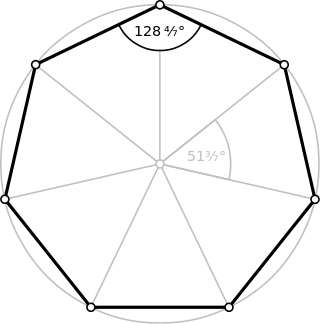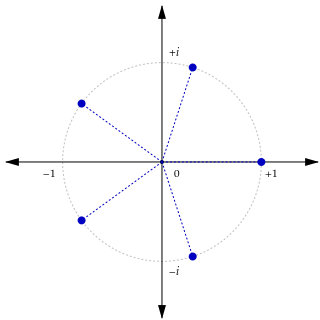Related Research Articles

In mathematics, a field is a set on which addition, subtraction, multiplication, and division are defined and behave as the corresponding operations on rational and real numbers do. A field is thus a fundamental algebraic structure which is widely used in algebra, number theory, and many other areas of mathematics.
In mathematics, a finite field or Galois field is a field that contains a finite number of elements. As with any field, a finite field is a set on which the operations of multiplication, addition, subtraction and division are defined and satisfy certain basic rules. The most common examples of finite fields are given by the integers mod p when p is a prime number.
In mathematics, in the area of abstract algebra known as Galois theory, the Galois group of a certain type of field extension is a specific group associated with the field extension. The study of field extensions and their relationship to the polynomials that give rise to them via Galois groups is called Galois theory, so named in honor of Évariste Galois who first discovered them.

In group theory, a branch of abstract algebra in pure mathematics, a cyclic group or monogenous group is a group, denoted Cn, that is generated by a single element. That is, it is a set of invertible elements with a single associative binary operation, and it contains an element g such that every other element of the group may be obtained by repeatedly applying the group operation to g or its inverse. Each element can be written as an integer power of g in multiplicative notation, or as an integer multiple of g in additive notation. This element g is called a generator of the group.

In mathematics, Galois theory, originally introduced by Évariste Galois, provides a connection between field theory and group theory. This connection, the fundamental theorem of Galois theory, allows reducing certain problems in field theory to group theory, which makes them simpler and easier to understand.
In number theory, the ideal class group of an algebraic number field K is the quotient group JK/PK where JK is the group of fractional ideals of the ring of integers of K, and PK is its subgroup of principal ideals. The class group is a measure of the extent to which unique factorization fails in the ring of integers of K. The order of the group, which is finite, is called the class number of K.
In mathematics, the Abel–Ruffini theorem states that there is no solution in radicals to general polynomial equations of degree five or higher with arbitrary coefficients. Here, general means that the coefficients of the equation are viewed and manipulated as indeterminates.

In mathematics, a root of unity, occasionally called a de Moivre number, is any complex number that yields 1 when raised to some positive integer power n. Roots of unity are used in many branches of mathematics, and are especially important in number theory, the theory of group characters, and the discrete Fourier transform.

Algebraic number theory is a branch of number theory that uses the techniques of abstract algebra to study the integers, rational numbers, and their generalizations. Number-theoretic questions are expressed in terms of properties of algebraic objects such as algebraic number fields and their rings of integers, finite fields, and function fields. These properties, such as whether a ring admits unique factorization, the behavior of ideals, and the Galois groups of fields, can resolve questions of primary importance in number theory, like the existence of solutions to Diophantine equations.
In mathematics, class field theory (CFT) is the fundamental branch of algebraic number theory whose goal is to describe all the abelian Galois extensions of local and global fields using objects associated to the ground field.
Field theory is the branch of mathematics in which fields are studied. This is a glossary of some terms of the subject.

In abstract algebra, a finite group is a group whose underlying set is finite. Finite groups often arise when considering symmetry of mathematical or physical objects, when those objects admit just a finite number of structure-preserving transformations. Important examples of finite groups include cyclic groups and permutation groups.
In mathematics, a Galois module is a G-module, with G being the Galois group of some extension of fields. The term Galois representation is frequently used when the G-module is a vector space over a field or a free module over a ring in representation theory, but can also be used as a synonym for G-module. The study of Galois modules for extensions of local or global fields and their group cohomology is an important tool in number theory.
In abstract algebra and number theory, Kummer theory provides a description of certain types of field extensions involving the adjunction of nth roots of elements of the base field. The theory was originally developed by Ernst Eduard Kummer around the 1840s in his pioneering work on Fermat's Last Theorem. The main statements do not depend on the nature of the field – apart from its characteristic, which should not divide the integer n – and therefore belong to abstract algebra. The theory of cyclic extensions of the field K when the characteristic of K does divide n is called Artin–Schreier theory.
In algebraic number theory, it can be shown that every cyclotomic field is an abelian extension of the rational number field Q, having Galois group of the form . The Kronecker–Weber theorem provides a partial converse: every finite abelian extension of Q is contained within some cyclotomic field. In other words, every algebraic integer whose Galois group is abelian can be expressed as a sum of roots of unity with rational coefficients. For example,
Kronecker's Jugendtraum or Hilbert's twelfth problem, of the 23 mathematical Hilbert problems, is the extension of the Kronecker–Weber theorem on abelian extensions of the rational numbers, to any base number field. That is, it asks for analogues of the roots of unity, as complex numbers that are particular values of the exponential function; the requirement is that such numbers should generate a whole family of further number fields that are analogues of the cyclotomic fields and their subfields.
In mathematics, Artin–Schreier theory is a branch of Galois theory, specifically a positive characteristic analogue of Kummer theory, for Galois extensions of degree equal to the characteristic p. Artin and Schreier (1927) introduced Artin–Schreier theory for extensions of prime degree p, and Witt (1936) generalized it to extensions of prime power degree pn.
In mathematics, a class formation is a topological group acting on a module satisfying certain conditions. Class formations were introduced by Emil Artin and John Tate to organize the various Galois groups and modules that appear in class field theory.
In mathematics, specifically the area of algebraic number theory, a cubic field is an algebraic number field of degree three.
In number theory, a cyclotomic field is a number field obtained by adjoining a complex root of unity to Q, the field of rational numbers.
References
- Kuz'min, L.V. (2001) [1994], "cyclotomic extension", Encyclopedia of Mathematics , EMS Press
- Weisstein, Eric W. "Abelian Extension". MathWorld .